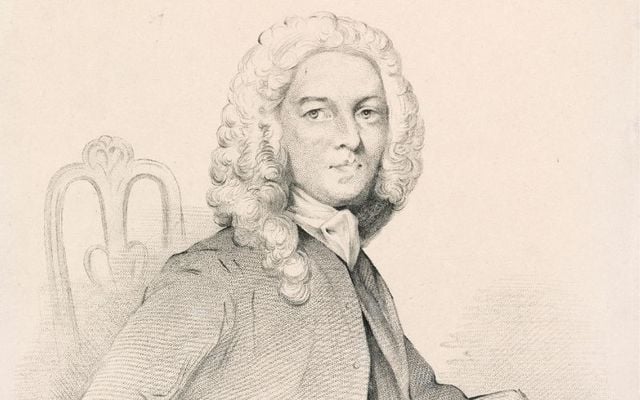The Rotunda Hospital in Dublin is the oldest continuously-running maternity hospital in the world and is nearing the birth of its one-millionth baby. However, the inspiring story of its founder, Bartholomew Mosse, has been largely overlooked in the pages of history.
Born in 1712 outside Portlaoise, Bartholomew Mosse studied medicine in Dublin and qualified as a surgeon by the time he turned 22.
Mosse, whose wife and child died in childbirth, was always concerned by the number of orphans on the streets of Dublin and resolved to do something about it, according to Pat Garry, a historian at the 14 Henrietta Street Museum, which tells Mosse's story.
Garry described Mosse as a "very proactive guy", adding that he took the "extremely rare" step of becoming a male midwife.
"There were only three male midwives on the island of Ireland at the time and there had only been five over the previous 50 years," Garry told IrishCentral.
Explaining this unusual career move, Garry said Mosse was clearly "a man of conscience way before his time", eschewing a lucrative role as a surgeon in the British Navy to help the "poorest of the poor" in Dublin.
By the time Mosse reached 30, he was determined to open a purpose-built maternity hospital and raised money to purchase an old theater on George's Lane, which he opened as the Lying-In Hospital in 1745.
Garry explained that the hospital got its name from Mosse's desire for women to come in a week before they gave birth so that the could be fully nourished. He also wanted them to remain in hospital a week after giving birth so that they could continue to receive care.
"That's why it was called the lying in hospital because he wanted patients to come in and relax for weeks."
Garry added that it was "very unusual" for any hospital to be purpose-built in the 18th century, especially maternity hospitals.
Demand at Mosse's Lying-In Hospital quickly outstripped the hospital's capacity, prompting Mosse to look for a bigger location.
He acquired four acres of land at the top of what is now O'Connell Street from the wealthy Gardiner family and set about acquiring funds to build the Rotunda Hospital.
To help generate funds for the new hospital, Mosse sold pieces of his newly-acquired land to members of the Irish gentry, helping to create what is now Parnell Square.
"He also ran concerts, recitals, fireworks displays, lotteries - you name it - until he eventually had enough money to build a hospital," Garry said.
With the funds secured, the Rotunda Hospital opened its doors in 1757, taking its name from a round entertainment room that Mosse built adjacent to the hospital to raise funds.
Since opening the Lying-In Hospital in 1745, Mosse prioritized hygiene, a revolutionary approach that greatly helped to reduce infant mortality, Garry said.
"Hygenic practices would have been unheard of at the time," Garry added. "Visitors came from all over Britain and Europe to look at the facilities in the hospital."
He also favored smaller wards to ensure greater privacy for women giving birth, another unusual step as hospital wards tended to be large at the time.
Furthermore, Mosse sought to replicate a domestic setting in his hospitals, providing a four-poster bed for every patient.
"It was very unusual to use four poster beds," Garry said. "For most, if not all women, it would have been their first time in any bed of any sort. He wanted that type of luxury for people giving birth."
By the time the Lying-In Hospital opened in 1745, however, Mosse was more of an impresario than a midwife, constantly running events to support and maintain the hospital.
"Everything was about raising money," Garry said, adding that Mosse was very successful in securing donations from Ireland's gentry.
Mosse died at the relatively young age of 47 from unexplained causes, which Garry attributes to a life's worth of sacrifices.
"All of his adult life was devoted to improving the lives of women and children in Dublin. He sacrificed everything he had."
His influence is plain to see. The Rotunda, which remains the world's oldest continuously-running maternity hospital, is expecting to see the delivery of its one-millionth baby in the coming months.
"That is a huge achievement," said Garry, who is quick to point out that the hospital has also ensured the survival of countless mothers over the past 300 years.
Today, maternity hospitals around the world house equipment featuring the name "Rotunda", a testament to the hospital's groundbreaking contribution to childbirth.

Love Irish history? Share your favorite stories with other history buffs in the IrishCentral History Facebook group.
However, Mosse has been almost completely forgotten in the city where he made such an impact.
"The guy isn't recognized anywhere," Garry said. "There's not a street; there's not an alleyway; there's not a laneway named after him. It's almost as if he's been totally forgotten."
His story is told at the 14 Henrietta Street Museum on the north side of Dublin City. A Georgian townhouse dating back to the early 18th century, the museum tells more than 300 years of social history, chronicling the fascinating journey from luxury townhouse to tenement flats.
The museum has come into possession of Mosse's four-poster bed after an anonymous donor attempted to donate it to the Rotunda Hospital.
"We're very lucky to be the only place that tells the story of Bartholomew Mosse and celebrates his great work," Garry said.




Comments